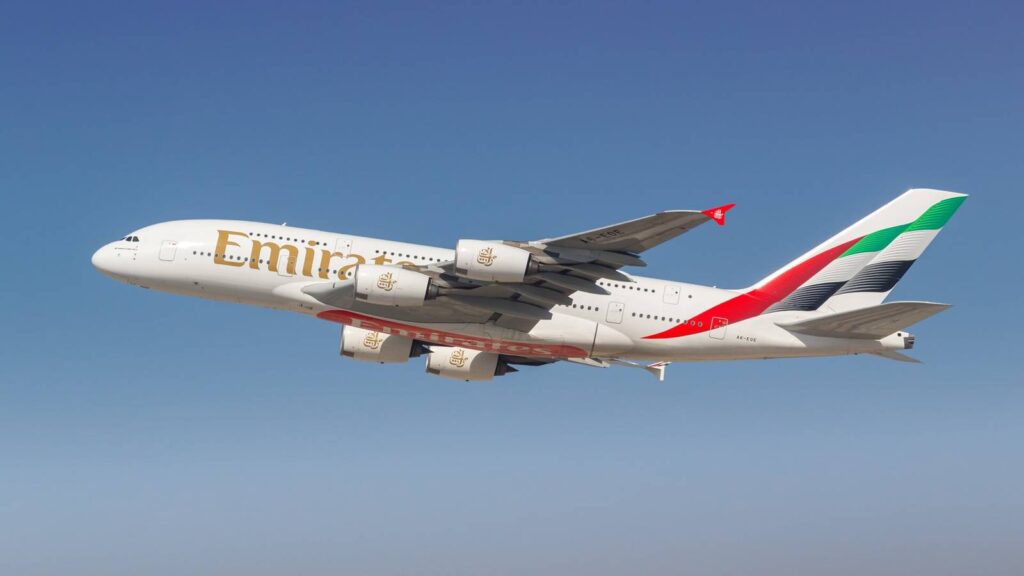
Emirates continues to push the limits of its flagship Airbus A380 fleet in 2025, operating some of the longest nonstop routes in the world. Despite the A380 being in the later stages of its production life, the aircraft remains central to Emirates’ long-haul operations. This year, the airline will operate flights with block times exceeding 16 hours, showcasing both the endurance of the aircraft and the scale of Emirates’ global hub in Dubai.
Ultra-long-haul flights are nothing new for Emirates, but their continued reliance on the Airbus A380 for these sectors underscores the jet’s unmatched capacity. Destinations across North America, Asia-Pacific, and Europe feature heavily among the longest nonstop sectors. While newer twin jets like the Airbus A350-900ULR and Boeing 777X are designed for range efficiency, Emirates’ A380s remain competitive thanks to strong demand. In 2025, these routes reaffirm the aircraft’s enduring place in global aviation, despite a shrinking operator base elsewhere.
Emirates’ Top Five Longest A380 Routes
Dubai (DXB) to Auckland (AKL) takes first place as the longest nonstop route operated by Emirates in 2025. The 16-hour flight operates seven days a week, a worthy first-place sitter. Alongside Auckland, Emirates operates several other marathon A380 routes that showcase just how far the superjumbo can fly. Los Angeles comes in second at 8,334 miles, another daily service that links Dubai with the west coast of the USA. Close behind is Dallas/Fort Worth at 8,165 miles, while San Francisco follows with 8,101 miles. Rounding out the list of top five is São Paulo at 7,591 miles, giving South America a key place in the Emirates’ long-haul network.
Each of these routes tells a story about connectivity and demand. Flights to Los Angeles and San Francisco demonstrate Emirates’ strong focus on the US market, tapping into both tourism and business travel. The daily Dallas service highlights the importance of Texas as an energy and commerce hub, while São Paulo represents Emirates’ growing presence in Latin America. By maintaining daily flights across all five of these long sectors, the airline shows confidence in filling the A380’s massive capacity.
Dubai to Auckland: The Longest Nonstop Flight
When it comes to the longest nonstop flight that Emirates’ A380 operates, nothing quite tops the Dubai (DXB) to Auckland (AKL) route. The mammoth trip covers 8,810 miles each way, stretching the limits of both the aircraft and the passengers onboard. Operated daily, it showcases how Emirates uses its hub to connect the two corners of the globe seamlessly, firmly establishing itself as the benchmark for ultra-long-haul travel.
The daily service between Dubai and Auckland is a clear example of how demand shapes airline operations. New Zealand’s geographic isolation means travelers often face long journeys regardless of their destinations, and Emirates steps in with a direct connection that avoids extra layovers. Covering more than 16 hours in the air, the route highlights both the range and capabilities of the A380, along with the logistical strength of Emirates’ network.
“The Auckland route is more than a record holder; it is a vital link between markets. Business and leisure travel all contribute to the steady demand that keeps the service running seven times a week.”
How Geography and Weather Shape Emirates’ Longest A380 Flight
While flying between Dubai and Auckland, geography plays a huge role in how the route is planned out. Although the great circle (shortest path over the Earth) is about 8,810 miles, in practice, the flight path can be longer due to airspace restrictions. According to flight data, recent recordings of the Auckland (AKL) – Dubai (DXB) route show distances ranging between 8,982 and 9,288 miles depending on weather variations.
Weather at high altitudes, especially the jet stream, has a pronounced effect on flight time for long-haul flights. Jet streams are strong, fast air currents in the upper atmosphere that typically flow from west to east. When flying from Auckland back to Dubai, or even departing Dubai, depending on the time of year, the aircraft might either catch a favorable tailwind or face a headwind. This means that even though the scheduled block time says one time, a delay can occur.
Seasonal climate patterns often further complicate flights. Storms, turbulence, or even closures can force rerouting. In 2023, Auckland airport was closed due to significant flooding, forcing rerouting, delays, and diversions. This all adds up to mean that the airline must monitor the forecasts, winds, and geopolitical airspace to ensure safety and efficiency.
Dubai to Los Angeles: Capacity, Connection, and Strategic Value
Coming in second place for the longest nonstop route Emirates uses the A380 on is Dubai to LAX. It’s a critical link not just for direct travel but for connecting passengers from many origins through Dubai into LA, including those from South Asia, the Middle East, and Africa. By offering 12,718 seats each way, Emirates maximizes economies of scale and spreads fixed costs over many travelers.
“Since launching in October 2008, the DXB–LAX route has carried over 3.5 million passengers and lifted about 252,000 tonnes of cargo in both directions, underlining its importance beyond just people movements.”
The connection between LAX and Dubai holds strategic weight for both regions. For Emirates, it strengthens its position as a global hub, enabling onward connections from LAX into Latin America, Asia, and Oceania. For Los Angeles and Southern California, the route supports both tourism and business links with the Middle East, India, and beyond, facilitating trade, cultural exchange, and travel flows.
Other Notable Destinations
Emirates continues to grow its presence in the Australasian market by offering direct flights to four Australian destinations. While the A380 travels direct to Perth daily, Emirates offers twice-daily Melbourne and Brisbane flights as well as 21 weekly flights to Sydney.
Emirates is the sole airline operating the Airbus A380 on the Dubai (DXB) to Perth (PER) route. This exclusive service underscores Emirates’ commitment to providing high-capacity, long-haul flights between the Middle East and Western Australia.
The airline supports thousands of jobs in aviation, tourism, and logistics locally, while also boosting Australia’s connectivity for conferences, business events, and leisure travel. Routes to Australia help Emirates maintain its position as a global connector, while providing Australians with convenient access to markets that would otherwise require multiple stops.
“Emirates’ nonstop services to Australia aren’t just about moving people; they also provide critical capacity for exports, especially high-value or perishable goods.”
Dubai to São Paulo: Emirates’ South American A380 Gateway
Emirates’ nonstop A380 service between Dubai and São Paulo (GRU) is the airline’s longest route to South America, covering 7,591 miles. Operating daily, it connects Brazil’s largest city directly to the Middle East and onwards to Europe, Africa, and Asia. For passengers, it’s a vital link that saves time compared to multi-stop itineraries, making Dubai a preferred hub for South American travelers heading east.
Beyond passengers, this route carries significant volumes of cargo in the A380’s cargo hold. Brazil exports high-value goods such as meat, coffee, fruit, and fashion to the Middle East and Asia, importing machinery, technology, and medical supplies. The airline made major infrastructure upgrades at São Paulo’s Guarulhos International Airport to make it fully A380-compatible, ensuring gates, taxiways, and ground handling can support the size and requirements of the super jumbo aircraft.
Strategically, DXB–GRU deepens ties between two regions that are geographically distant but economically complementary. For Brazil, the connection boosts tourism and trade, opening new markets for exporters. For Emirates, it strengthens its global footprint by linking South America to its Dubai hub, where passengers and cargo can transfer seamlessly to more than 140 destinations worldwide.




